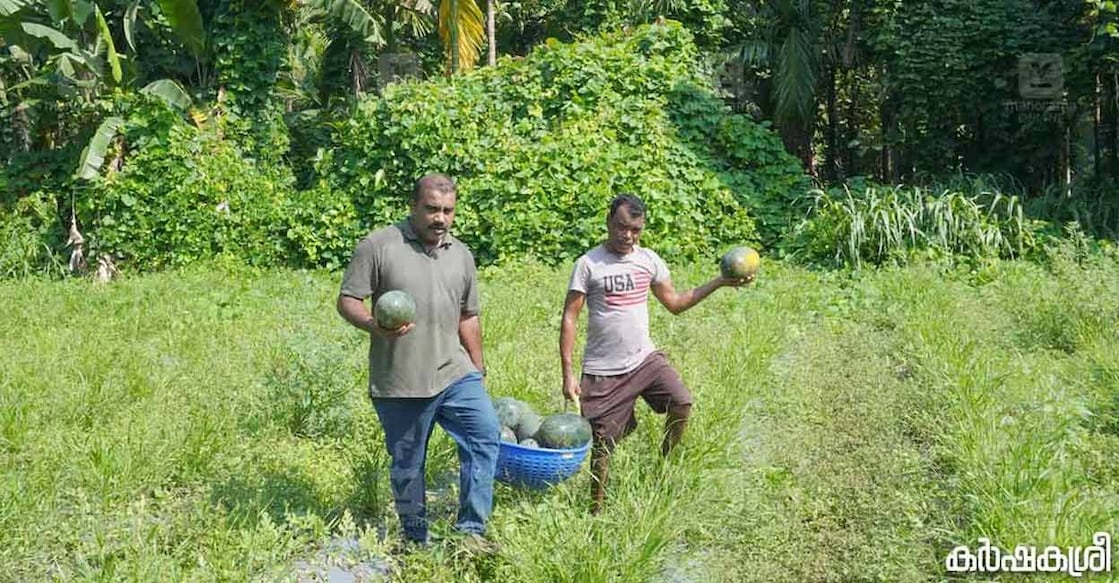Here's how software engineer-turned farmer gets windfall through innovative methods

Mail This Article
Though he studied and worked in the IT sector, S Ajith from Pala, had a passion for farming. Ajith, who ran his own IT company in Ernakulam, was inspired to take up farming during the COVID-19 period. He shifted his work to work-from-home and ventured into farming thereafter. He cleared the rubber trees on his land near the Meenachil River and started cultivating vegetables. Ajith says that the farming he started during the COVID-19 period has only brought him benefits. He approached farming scientifically, reducing labour issues and workload. The Krishi Bhavan (Agricultural Department) of Mutholli Panchayat also supported him.
Ajith's farming has completed five years now. Along with many vegetables, he also cultivated watermelons. He first cultivated watermelons on 75 cents of land two years ago and had a good harvest. Now, it has expanded to six acres. This year, he cultivated watermelons alone, without allocating space for other vegetables. He also cultivates strawberries in Wagamon. There is no other farm in Kottayam district with such a large watermelon cultivation. From January to the present, he has sold 60,000 kg of watermelons. About 500 kg were lost due to heavy rain. However, Ajith expects to harvest another 2000 kg.
Land preparation begins in September-October. The first step is to clean the farm, add lime, and adjust the pH. After preparing the beds with cow dung, chicken manure, sheep manure, and neem cake, a drip irrigation line is installed, and mulch sheets are laid. The beds are spaced four feet apart. This spacing is to allow for planting beans in the same beds after the watermelon harvest in May. Ajith says that a six-foot spacing would improve the growth and yield of watermelons.
Seeds are sown the day after laying the mulch sheet. Four packets of seeds are required per acre. A packet costing ₹4000 contains 1000 seeds. Seeds are purchased online through seed company websites. He studies which variety is best each year before purchasing seeds. This year, he bought the Sugar Queen variety. He also cultivated the Mukasa variety in another plot. Although there is not much difference in size and colour between the two, Ajith says Mukasa has a slightly better taste and shelf life.
The first fruits are larger; watermelons weighing up to 6 kg have been harvested from this farm. However, the average weight is 3 kg. An average of 5 fruits are obtained from one plant. Pruning is also important for watermelons. Ajith says that pruning this time resulted in more shoots and vines, leading to a higher yield.
Ajith's farm might appear overgrown with weeds. But Ajith says weeds are beneficial for watermelons. Since he practices precision farming with mulch sheets, the fertilizers and water are not absorbed by weeds. However, weeds growing between the beds prevent the melons from scorching in the daytime heat. Melons that are scorched in direct sunlight become unsaleable and lose their flavour. He usually discards such watermelons. Recently, heavy rains have also damaged some melons lying on the ground. He removes the damaged ones.

Cultivation was done in three batches, aiming for harvesting from January to May. So far, 60,000 kg have been sold. 50,000 kg were sold at ₹40 per kg, and the remaining 10,000 kg at ₹30 per kg. In short, an income of ₹23 Lakhs from six acres!
Native watermelon, WhatsApp market
Direct sales to customers are done here. People from far and wide come to his farm after hearing about the watermelon cultivation. Customers come directly after seeing advertisements on the farm's social media group. Initially, many people were doubtful about the taste since it was the first time watermelons were grown in Pala. He convinced them by providing samples. This practice continues. Ajith says many people who tasted the watermelons have returned to buy more. Harvesting and sales are done in the morning. Sales are through an outlet adjacent to the farm. The watermelons, covered in morning frost, have a unique coolness and taste. The direct-from-plant-to-customer approach ensures the taste is not compromised.
As he combines software job with farming many ask whether farming is profitable. And he promptly responds, “This is a question everyone asks. There is only one answer. If you have even a little interest and sincerity in farming, you can make it successful. Traditional farmers achieve good production but lack marketing skills. Reducing the workload on the farm allows them to find time for sales. The farmer should first think about marketing. Only then can one think about the cultivation, the yield, and the maintenance.”

Not just vegetables, but also strawberries
While cultivating watermelons in Pala, he also cultivates strawberries in Wagamon with a friend. Ajith says that the farm tourism model they adopted at the Lavender Resort in Wagamon was successful. Since visitors are allowed to harvest themselves, there is a high demand for that. This year's strawberry season is over. The next season will begin around August-September.

